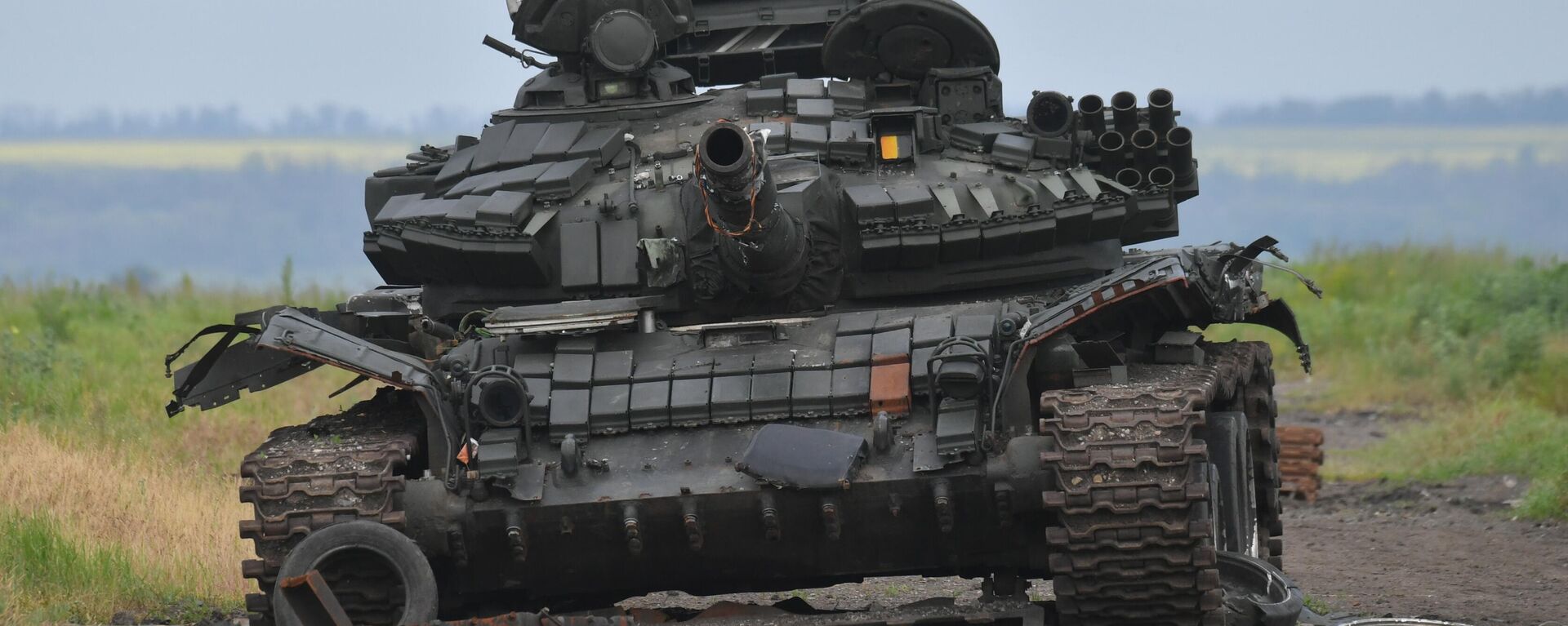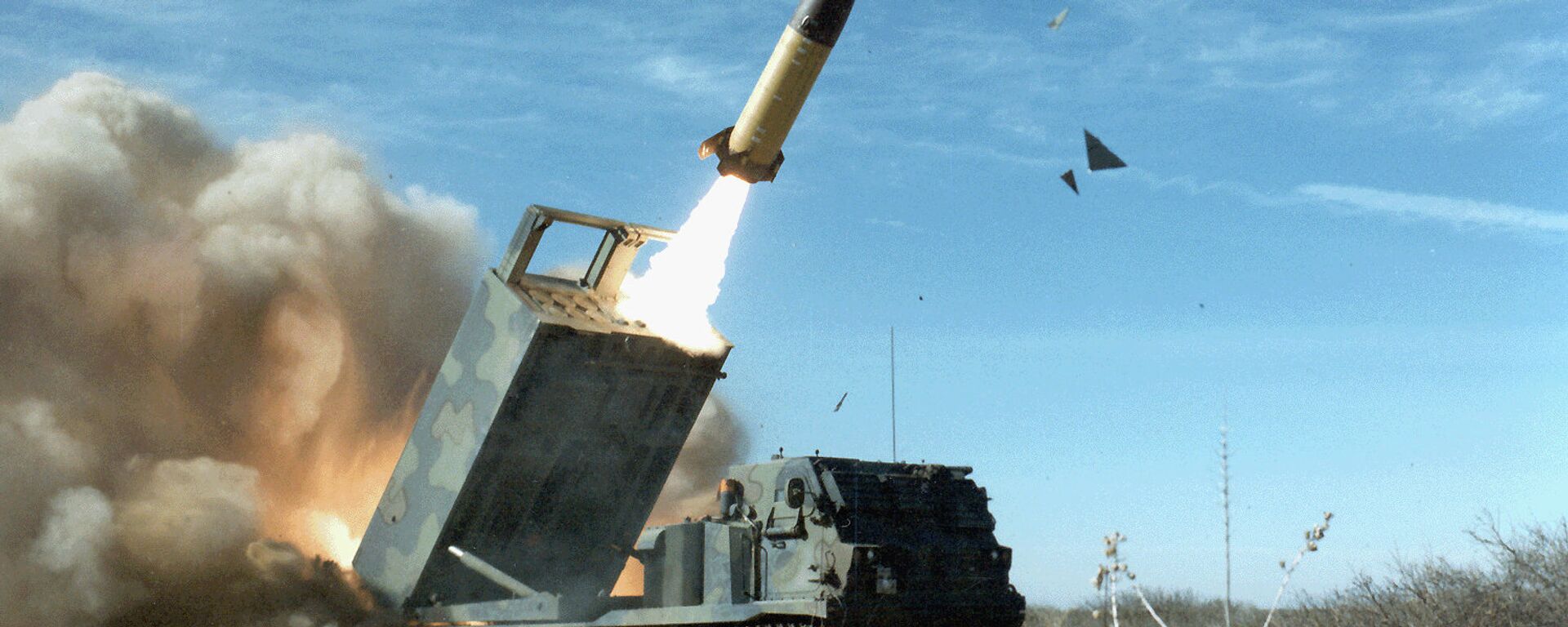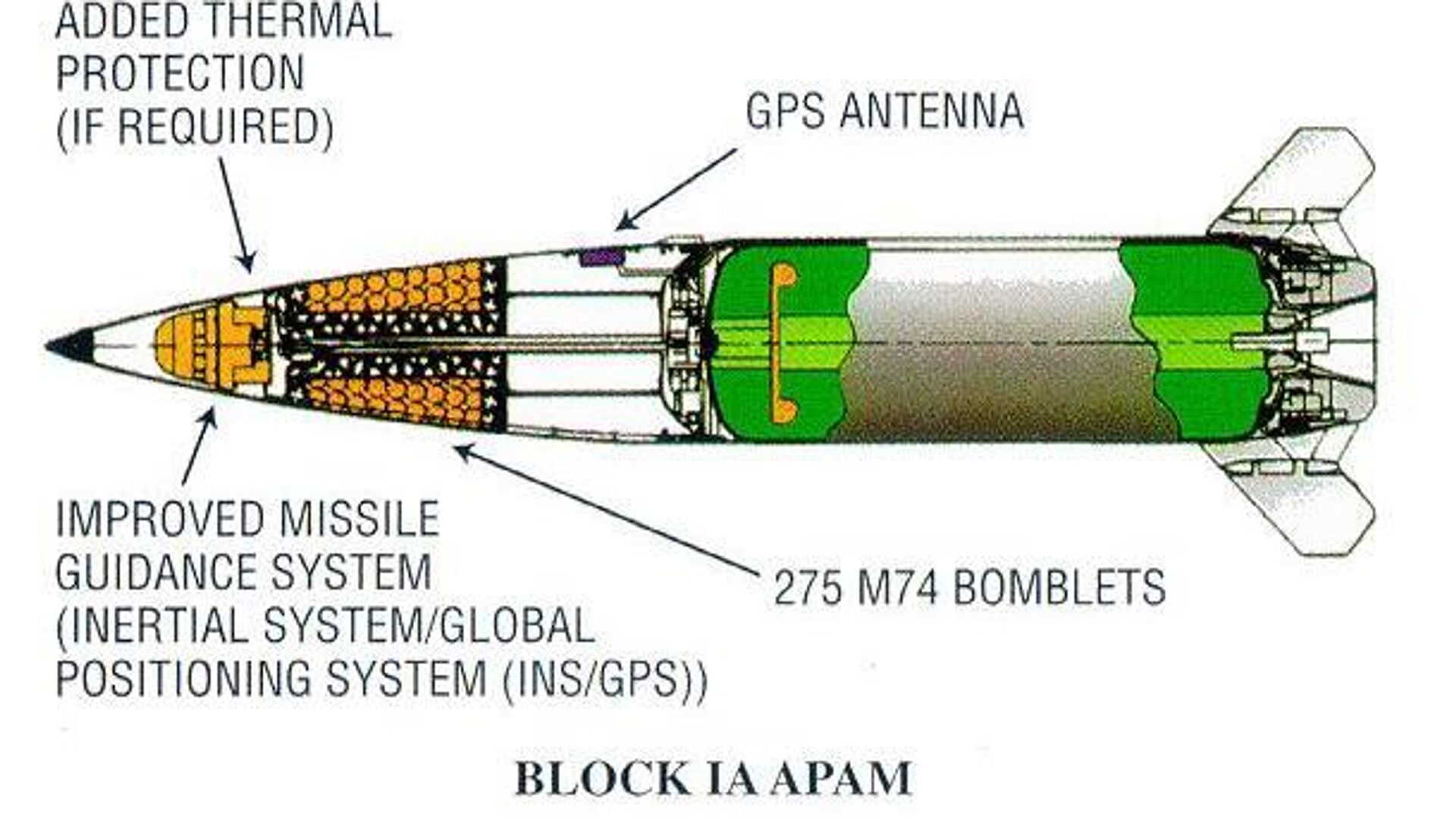https://sputnikglobe.com/20230912/scott-ritter-us-transfer-of-ever-more-deadly-arms-to-ukraine-reeks-of-desperation-1113319569.html
Scott Ritter: US Transfer of Ever More Deadly Arms to Ukraine Reeks of Desperation
Scott Ritter: US Transfer of Ever More Deadly Arms to Ukraine Reeks of Desperation
Sputnik International
The Biden administration is reportedly on the verge of approving the delivery of ultra-long-range ATACMS or GMLRS missiles to Ukraine, with their deployment expected to enable to Kiev to strike deep into the Russian hinterland. Scott Ritter has a simple theory about why the White House is pursuing such a dangerous march up the escalation ladder.
2023-09-12T17:46+0000
2023-09-12T17:46+0000
2023-09-12T18:49+0000
analysis
joe biden
volodymyr zelensky
ukraine
russia
nato
army tactical missile system (atacms)
gmlrs
high mobility artillery rocket system (himars)
https://cdn1.img.sputnikglobe.com/img/07e7/05/1e/1110800671_0:15:611:358_1920x0_80_0_0_3329e28c78a826243633e6675fcdfddd.jpg
Officials in Washington have confirmed to US media over the weekend and on Monday that the United States is planning to send Army Tactical Missile System (ATACMS) and/or Guided Multiple Launch Rocket System (GMLRS) munitions to Ukraine.ATACMS have a range of over 305 km, and can carry about 300 high-explosive bomblets. GMLRS have a range of over 70 km, with an extended range (ER) variant capable of firing in excess of 150 km, and are packed with cluster munitions. Both pieces of ordnance can be fired from ground-based launchers that the US has already delivered to Ukraine, including the M270 Multiple Launch Rocket System (MLRS), and the M142 High Mobility Artillery Rocket System (HIMARS).Over the past year-and-a-half, the US and its NATO allies have adopted a cautious, "two steps forward, one step back" approach to arming Kiev, first assuring that various weapons (be it cluster munitions and long-range cruise missiles or tanks and F-16 fighter jets) would not be sent, citing the danger of escalation tensions with Russia, and then announcing their delivery weeks or months later."The Biden administration seems to be going through a Dr. Jekyll and Mr. Hyde-type phase when it comes to the nature of the weapons that it’s willing to provide to Ukraine," Scott Ritter, a veteran former US Marine Corps intelligence officer, UN weapons inspector, and military analyst, told Sputnik. "A year ago, the Biden administration was very reticent about providing certain categories of weapons out of fear to create the potential of an escalation between the United States, between NATO and Russia over Ukraine. The last thing the United States wanted, or so the Biden administration said, was a direct war with Russia."Why Escalation Smells of DesperationDesperation over sobering battlefield realities and a desire to "harm Russia," rather than hopes that the new long-range weapons could turn the tide in the conflict, are the main motivators behind the Biden administration’s escalation strategy, the observer believes."The Ukrainians, according to Russian President Vladimir Putin, have suffered 71,000 casualties over the course of the last four months in a failed counteroffensive effort. And there's nothing about the nature of these weapons that would improve Ukraine's chances on the battlefield. These weapons that are being provided are being provided to provide Ukraine with the potential of doing harm to Russia. The ATACMS missiles being provided, simply put, to strike the Crimea Bridge, to destroy that bridge, to enable Ukraine to strike targets deep in the Russian rear area - airfields, command posts, logistics. This is a dramatic escalation of the conflict," Ritter stressed."We'll see how this unfolds. My bet is that Russia, a nation that has a history of absorbing 27 million dead in the cause of defeating fascism, defeating Nazism, isn't going to yield to any threats being made by the United States. But we'll find out," Ritter summed up.Ukrainian Proxy's Terror TacticsAt every step up the escalation ladder, the US and its Zelensky regime proxies have assured their constituents and the international community that Ukraine wouldn't use its NATO-delivered weapons to target civilians or civilian infrastructure. At the same time, at every step, the Ukrainian military has demonstrated its readiness to use cluster munitions, HIMARS, and Storm Shadow missiles against civilians in Donbass, to target infrastructure in Crimea, Belgorod, and Voronezh, and to attack Russian infrastructure, including cites like Moscow, and the Kursk Nuclear Power Plant, with long-range drone-based sabotage strikes.To date, Russia has been able to effectively use a variety of defensive platforms, from short, medium and long-range air defense missile systems to electronic warfare jammers, to defend borders and cities against Ukrainian attacks. Today, the main issue for Russia's air defenses revolves around the Ukrainian military’s attempts find holes in the 1,000+ km frontline's air defenses, and to plug any existing gaps.
https://sputnikglobe.com/20230912/as-ammo-dries-up-us-set-to-shift-blame-for-ukraine-counteroffensive-debacle--1113298286.html
https://sputnikglobe.com/20230911/nuland-lets-slip-us-supports-ukraine-targeting-russias-most-precious-assets-1113274419.html
ukraine
russia
Sputnik International
feedback@sputniknews.com
+74956456601
MIA „Rosiya Segodnya“
2023
News
en_EN
Sputnik International
feedback@sputniknews.com
+74956456601
MIA „Rosiya Segodnya“
Scott Ritter, a military analyst and former US Marine Corps intelligence officer, commented on the US's march up the escalation ladder.
Sputnik International
Scott Ritter, a military analyst and former US Marine Corps intelligence officer, commented on the US's march up the escalation ladder.
2023-09-12T17:46+0000
true
PT3M26S
Sputnik International
feedback@sputniknews.com
+74956456601
MIA „Rosiya Segodnya“
scott ritter, united states, russia, nato, ukraine, proxy war, atacms, long-range, missile, strikes, capabilities, desperation
scott ritter, united states, russia, nato, ukraine, proxy war, atacms, long-range, missile, strikes, capabilities, desperation
Scott Ritter: US Transfer of Ever More Deadly Arms to Ukraine Reeks of Desperation
17:46 GMT 12.09.2023 (Updated: 18:49 GMT 12.09.2023) The Biden administration is reportedly on the verge of approving the delivery of ultra-long-range ATACMS or GMLRS missiles to Ukraine, with their deployment expected to enable Kiev to strike deep into the Russian hinterland. Scott Ritter has a simple theory about why the White House is pursuing such a dangerous march up the escalation ladder.
Officials in Washington have
confirmed to US media over the weekend and on Monday that the United States is planning to send Army Tactical Missile System (ATACMS) and/or Guided Multiple Launch Rocket System (GMLRS) munitions to Ukraine.
"They are coming," one official familiar with the administration’s security assistance plans
said, referring to ATACMS.
ATACMS have a range of over 305 km, and can carry about 300 high-explosive bomblets. GMLRS have a range of over 70 km, with an extended range (ER) variant capable of firing in excess of 150 km, and are packed with cluster munitions. Both pieces of ordnance can be fired from ground-based launchers that the US has already delivered to Ukraine, including the M270 Multiple Launch Rocket System (MLRS), and the M142 High Mobility Artillery Rocket System (HIMARS).
Over the past year-and-a-half, the US and its NATO allies have adopted a cautious, "two steps forward, one step back"
approach to arming Kiev, first assuring that various weapons (be it cluster munitions and long-range cruise missiles or tanks and
F-16 fighter jets) would not be sent, citing the danger of escalation tensions with Russia, and then announcing their delivery weeks or months later.
"The Biden administration seems to be going through a Dr. Jekyll and Mr. Hyde-type phase when it comes to the nature of the weapons that it’s willing to provide to Ukraine," Scott Ritter, a veteran former US Marine Corps intelligence officer, UN weapons inspector, and military analyst, told Sputnik. "A year ago, the Biden administration was very reticent about providing certain categories of weapons out of fear to create the potential of an escalation between the United States, between NATO and Russia over Ukraine. The last thing the United States wanted, or so the Biden administration said, was a direct war with Russia."
"Today, all of those inhibitions seem to have been swept away. We see the United States providing M1 Abrams tanks. We see the United States authorizing the delivery of F-16 fighters. And now the United States is considering to provide Ukraine with the ATACMS long-range missile system or the guided multiple launch rocket system, a 45-mile range rocket system delivered by the HIMARS system that has extreme accuracy and could deliver cluster munitions. This, of course, follows on the heels of the decision by the Biden administration made earlier this year to provide Ukraine with the cluster variant of the 155-millimeter artillery shell," Ritter said.
Why Escalation Smells of Desperation
Desperation over sobering battlefield realities and a desire to "harm Russia," rather than hopes that the new long-range weapons could turn the tide in the conflict, are the main motivators behind the Biden administration’s escalation strategy, the observer believes.
"The Ukrainians, according to Russian President Vladimir Putin, have suffered 71,000 casualties over the course of the last four months in a failed counteroffensive effort. And there's nothing about the nature of these weapons that would improve Ukraine's chances on the battlefield. These weapons that are being provided are being provided to provide Ukraine with the potential of doing harm to Russia. The ATACMS missiles being provided, simply put, to strike the Crimea Bridge, to destroy that bridge, to enable Ukraine to strike targets deep in the Russian rear area - airfields, command posts, logistics. This is a dramatic escalation of the conflict," Ritter stressed.

12 September 2023, 13:14 GMT
"Why is the Biden administration doing this? Frankly speaking, it's out of an act of desperation. Look, anybody who looks at the situation on the ground in Ukraine knows that Ukraine is losing, Russia is winning. And literally there's nothing that can be done to prevent a Russian victory. The provision of ATACMS rockets, the GMLRS rocket system isn't going to change the outcome on the battlefield. What it will do is provide Ukraine the opportunity to inflict more harm on Russia," and that, Washington may be hoping, will put political pressure on Moscow domestically, the observer explained.
"We'll see how this unfolds. My bet is that Russia, a nation that has a history of absorbing 27 million dead in the cause of defeating fascism, defeating Nazism, isn't going to yield to any threats being made by the United States. But we'll find out," Ritter summed up.

11 September 2023, 12:39 GMT
Ukrainian Proxy's Terror Tactics
At every step up the escalation ladder, the US and its Zelensky regime proxies have
assured their constituents and the international community that Ukraine wouldn't use its NATO-delivered weapons to target civilians or civilian infrastructure. At the same time,
at every step, the Ukrainian military has demonstrated its readiness to use cluster munitions, HIMARS, and Storm Shadow missiles against civilians in Donbass, to target infrastructure in Crimea, Belgorod, and Voronezh, and to attack Russian infrastructure, including cites like Moscow, and the Kursk Nuclear Power Plant, with long-range drone-based sabotage strikes.
To date, Russia has been able to effectively use a variety of defensive platforms, from short, medium and long-range air defense missile systems to electronic warfare jammers, to defend borders and cities against Ukrainian attacks. Today, the main issue for Russia's air defenses revolves around the Ukrainian military’s attempts find holes in the 1,000+ km frontline's air defenses,
and to plug any existing gaps.







